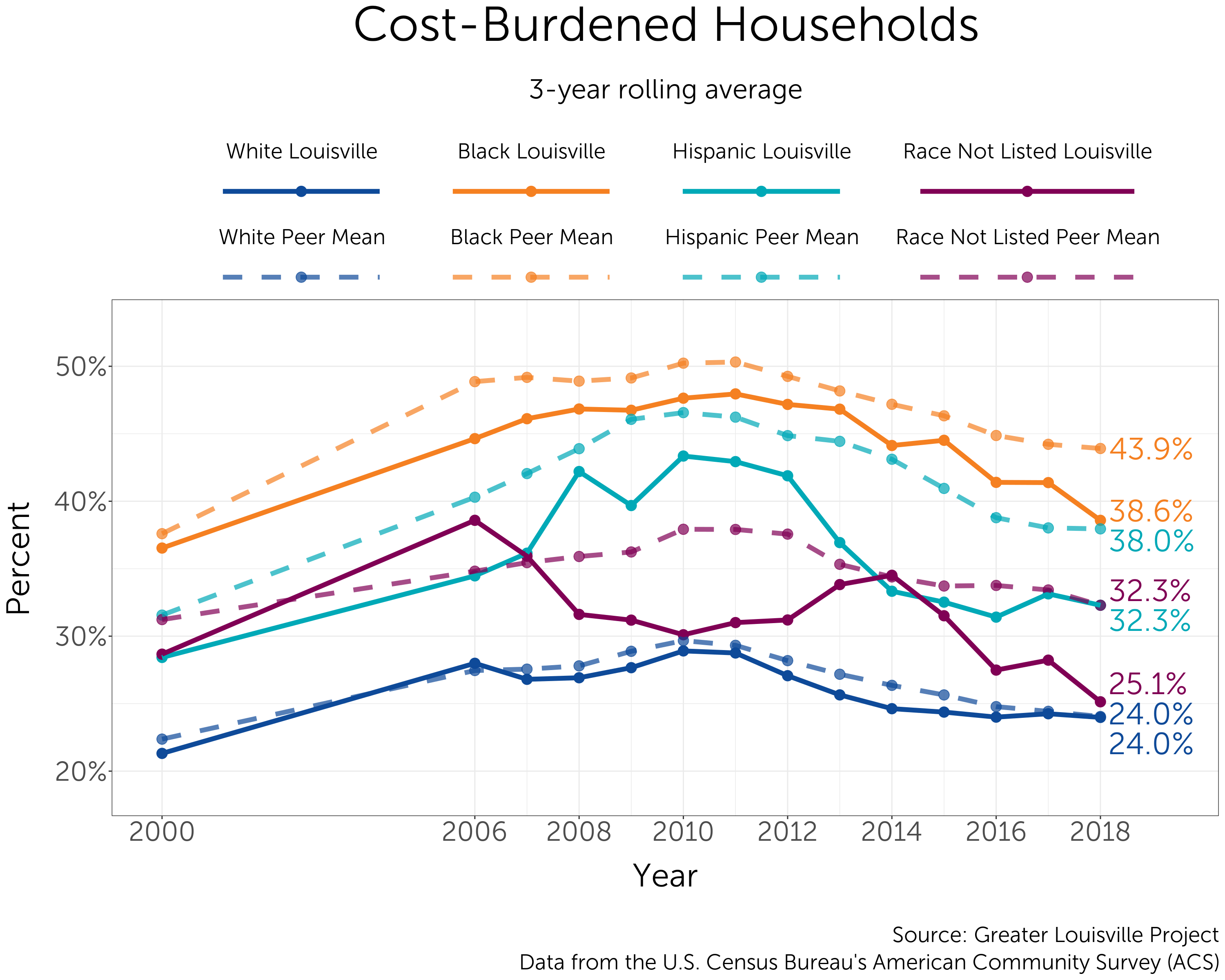
Cost-Burdened Households
Households that spend more than 30% of their income on housing are considered cost-burdened and may not have money for necessary expenses such as food, clothing, or transportation. Cost-burdened households have a lower quality of life and are less equipped to navigate unexpected financial crises. Ensuring that all residents have access to affordable housing creates a more prosperous and equitable Louisville.
Peer City Perspective
Louisville currently ranks 3rd among its peers in the percentage of households that spend 30% or more of their income on rent or mortgage expenses.
That puts Louisville in the top tier of its peers according to a natural breaks algorithm. Cities in green are those that outperform their peers. Cities in yellow represent the middle cluster, and those in red lag behind their peers on this indicator.

Where are the cost burdened homes in Louisville?
Neighborhoods with high incomes tend to have the lowest percentages of cost-burdened homes: only 12% of Belknap residents in the Highlands and 15% of Eastwood-Long Run residents in East Louisville live in unaffordable housing. Neighborhoods in West Louisville and around the University of Louisville have the highest rates of cost-burdened households. In the California neighborhood, 55% of households are cost-burdened.
Trends over Time
Over the last two decades, the percentage of cost-burdened households in Louisville and its peer cities has risen sharply and since fallen. Toward the end of the last decade, Louisville saw a decreasing percentage of cost-burdened households and rose to the top-performing quartile of its peers.


Best and Worst Peer Performers
Indianapolis saw its percentage of cost-burdened households rise by more than 8 percentage points over the last two decades, making it the worst performer of the group. In contrast, Greenville’s cost-burdened household percentage only rose by about 1 percentage point over the same time period, making it the best performer. Louisville’s percentage has increased by a little more than 3 percentage points.
Differences by Sex
In Louisville and its peer cities, significantly more women than men live in cost-burdened households. However, for both men and women, the rate has been decreasing in recent years.


Differences by Race
In Louisville, nearly 39% of Black residents live in cost-burdened households. That’s higher than Hispanic residents (about 32%) and White residents (24%). The percentage of cost-burdened households among Black and Hispanic residents is even higher in Louisville’s peer cities.
Continue Exploring with Related Data
Natural Breaks Algorithm
For each indicator, Greater Louisville Project assigns cities into one of three groups (high-performing, middle-of-the-pack, and low-performing) based on how they compare to other cities. The assignment is based on how cities naturally cluster on that indicator. Sometimes, the differences between cities are very small, and the difference between a city ranked 5th and 6th could simply be a matter of the sampling error that arises from using survey data. Thus, rather than always make a division that declares the top 5 to be the top tier, we use a natural breaks algorithm to look for a cluster of cities that is outperforming the rest, a cluster that is about average, and a cluster that is lagging. This clustering gives us a better indication of where Louisville is thriving and where Louisville has room to learn from cities that are doing better.
Z-Scores
Z-scores (or standardization) is a way to combine data with different units of measurement into a single index. The z-score is a measure of how far away a city (or census tract, etc.) is from the average city. In order to be comparable across different units of measurement, the z-score is the distance from the mean measured in standard deviations (e.g. if Louisville has a z-score of 1 it means Louisville is 1 standard deviation above the mean of its peer cities).
Data from the Robert Wood Johnson Foundation's County Health Rankings use z-scores and all z-scores are relative to the mean of Louisville's peer cities. (On the County Health Rankings site z-scores are relative to all the counties in each state - thus z-scores reported by GLP will be different, because we are using a different reference group). The Greater Louisville Project also uses z-scores in our multidimensional poverty index, which compares each census tract to the mean of all census tracts in Louisville.
